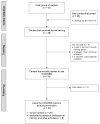Implementation and Outcomes of a Collaborative Multi-Center Network Aimed at Web-Based Cognitive Training - COGWEB Network
- PMID: 26543902
- PMCID: PMC4607396
- DOI: 10.2196/mental.3840
Implementation and Outcomes of a Collaborative Multi-Center Network Aimed at Web-Based Cognitive Training - COGWEB Network
Abstract
Background: Cognitive care for the most prevalent neurologic and psychiatric conditions will only improve through the implementation of new sustainable approaches. Innovative cognitive training methodologies and collaborative professional networks are necessary evolutions in the mental health sector.
Objective: The objective of the study was to describe the implementation process and early outcomes of a nationwide multi-organizational network supported on a Web-based cognitive training system (COGWEB).
Methods: The setting for network implementation was the Portuguese mental health system and the hospital-, academic-, community-based institutions and professionals providing cognitive training. The network started in August 2012, with 16 centers, and was monitored until September 2013 (inclusions were open). After onsite training, all were allowed to use COGWEB in their clinical or research activities. For supervision and maintenance were implemented newsletters, questionnaires, visits and webinars. The following outcomes were prospectively measured: (1) number, (2) type, (3) time to start, and (4) activity state of centers; age, gender, level of education, and medical diagnosis of patients enrolled.
Results: The network included 68 professionals from 41 centers, (33/41) 80% clinical, (8/41) 19% nonclinical. A total of 298 patients received cognitive training; 45.3% (n=135) female, mean age 54.4 years (SD 18.7), mean educational level 9.8 years (SD 4.8). The number enrolled each month increased significantly (r=0.6; P=.031). At 12 months, 205 remained on treatment. The major causes of cognitive impairment were: (1) neurodegenerative (115/298, 38.6%), (2) structural brain lesions (63/298, 21.1%), (3) autoimmune (40/298, 13.4%), (4) schizophrenia (30/298, 10.1%), and (5) others (50/298, 16.8%). The comparison of the patient profiles, promoter versus all other clinical centers, showed significant increases in the diversity of causes and spectrums of ages and education.
Conclusions: Over its first year, there was a major increase in the number of new centers and professionals, as well as of the clinical diversity of patients treated. The consolidation of such a national collaborative network represents an innovative step in mental health care evolution. Furthermore, it may contribute to translational processes in the field of cognitive training and reduce disease burden.
Keywords: cognitive training; collaborative network; dementia; eHealth systems; memory clinic; mental health services; neurorehabilitation; schizophrenia; stroke.
Conflict of interest statement
Conflicts of Interest: VTC and JP have a shareholder position at Neuroinova, Lda, a company that develops and commercializes COGWEB related products. VB and MC received fees for the technological development of COGWEB.
Figures



Similar articles
-
Web-based cognitive training: patient adherence and intensity of treatment in an outpatient memory clinic.J Med Internet Res. 2014 May 7;16(5):e122. doi: 10.2196/jmir.3377. J Med Internet Res. 2014. PMID: 24808451 Free PMC article.
-
From concept to application: the impact of a community-wide intervention to improve the delivery of preventive services to children.Pediatrics. 2001 Sep;108(3):E42. doi: 10.1542/peds.108.3.e42. Pediatrics. 2001. PMID: 11533360 Clinical Trial.
-
A rehabilitation tool designed for intensive web-based cognitive training: description and usability study.JMIR Res Protoc. 2013 Dec 13;2(2):e59. doi: 10.2196/resprot.2899. JMIR Res Protoc. 2013. PMID: 24334248 Free PMC article.
-
[What support of young presenting a first psychotic episode, when schooling is being challenged?].Encephale. 2017 Dec;43(6):570-576. doi: 10.1016/j.encep.2017.10.001. Epub 2017 Nov 8. Encephale. 2017. PMID: 29128195 Review. French.
-
Systematic reviews of the effectiveness of day care for people with severe mental disorders: (1) acute day hospital versus admission; (2) vocational rehabilitation; (3) day hospital versus outpatient care.Health Technol Assess. 2001;5(21):1-75. doi: 10.3310/hta5210. Health Technol Assess. 2001. PMID: 11532238 Review.
Cited by
-
Capturing Expert Knowledge for the Personalization of Cognitive Rehabilitation: Study Combining Computational Modeling and a Participatory Design Strategy.JMIR Rehabil Assist Technol. 2018 Dec 6;5(2):e10714. doi: 10.2196/10714. JMIR Rehabil Assist Technol. 2018. PMID: 30522994 Free PMC article.
-
A comparison of two personalization and adaptive cognitive rehabilitation approaches: a randomized controlled trial with chronic stroke patients.J Neuroeng Rehabil. 2020 Jun 16;17(1):78. doi: 10.1186/s12984-020-00691-5. J Neuroeng Rehabil. 2020. PMID: 32546251 Free PMC article. Clinical Trial.
-
International Experience of Implementing Cognitive Remediation for People With Psychotic Disorders.Schizophr Bull. 2024 Aug 27;50(5):1017-1027. doi: 10.1093/schbul/sbae071. Schizophr Bull. 2024. PMID: 38758086 Free PMC article.
References
-
- Cunningham FC, Ranmuthugala G, Plumb J, Georgiou A, Westbrook JI, Braithwaite J. Health professional networks as a vector for improving healthcare quality and safety: A systematic review. BMJ Qual Saf. 2012 Mar;21(3):239–249. doi: 10.1136/bmjqs-2011-000187. http://qualitysafety.bmj.com/cgi/pmidlookup?view=long&pmid=22129933 bmjqs-2011-000187 - DOI - PMC - PubMed
-
- Chauvet V, Chollet B, Soda G, Huault I. The contribution of network research to managerial culture and practice. European Management Journal. 2011 Oct;29(5):321–334. doi: 10.1016/j.emj.2011.06.005. http://www.sciencedirect.com/science/article/pii/S0263237311000430 - DOI
-
- Borgatti SP, Halgin DS. On network theory. Organization Science. 2011 Oct;22(5):1168–1181. doi: 10.1287/orsc.1100.0641. http://pubsonline.informs.org/doi/abs/10.1287/orsc.1100.0641?journalCode... - DOI - DOI
-
- Lang PB, Gouveia FC, Leta J. Cooperation in health: Mapping collaborative networks on the web. PLoS One. 2013;8(8):e71415. doi: 10.1371/journal.pone.0071415. http://dx.plos.org/10.1371/journal.pone.0071415 PONE-D-13-06930 - DOI - DOI - PMC - PubMed
LinkOut - more resources
Full Text Sources
Other Literature Sources

